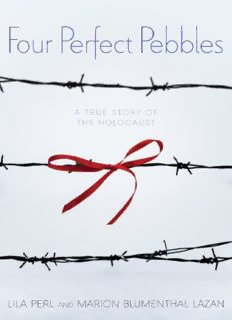
Four Perfect Pebbles: A True Story of the Holocaust PDF
Preview Four Perfect Pebbles: A True Story of the Holocaust
Child’s identification card bearing the Nazi coat of arms, issued to Marion Blumenthal, age three and a half, in Hoya, Germany, on June 10, 1938 DEDICATION T o Joan Newman, to whom I am deeply grateful for the privilege of having met Marion Blumenthal Lazan. —L. P. T o my mother, Ruth Blumenthal Meyberg, who carried the full burden and whose love and perseverance saw us through, and to my husband, Nathaniel, whose deep devotion has made the perpetuation of our heritage possible. And in memory of my father, Walter Blumenthal, who would have derived great joy and fulfillment from his three grandchildren—David, Susan, and Michael—and nine great-grandchildren—Arielle, Joshua, Gavriel, Dahlia, Yoav, Jordan Erica, Hunter, Ian, and Kasey Rose. To all those who have known adversity and despair, I offer my belief that out of darkness can come light. —M. B. L. CONTENTS Dedication Prologue 1. “Four Perfect Pebbles” 2. “A Small Town in Germany” 3. “Get Dressed and Come with Us” Photo Insert 4. “Escape to Holland” 5. “The Greatest Disappointment” 6. “On the Death Train” Photo Insert 7. “Freedom and Sorrow” 8. “Holland Again” 9. “America, at Last” Epilogue Bibliography Map: Germany and Surrounding Nations, 2016 Afterword to Twentieth Anniversary Edition Photo Insert Praise Credits Copyright About the Publisher PROLOGUE T his is the story of a family—a mother and father and their two young children —who became trapped in Hitler’s Germany. They managed eventually to leave that country for Holland, where they were soon again caught in the Nazis’ web, and their situation grew even more serious. For in the final years of World War II, when the Holocaust reached its most feverish pitch, the four members of the Blumenthal family were returned to Germany. During their ordeal, lasting six and a half years, the Blumenthals lived in refugee, transit, and prison camps that included Westerbork in Holland and the notorious concentration camp at Bergen-Belsen in Germany. Bergen-Belsen was the camp to which Anne Frank and her sister, Margot, were transported in October 1944. The two girls, aged fifteen and nineteen, died there of typhus in March 1945. It was in the very same section of Bergen-Belsen that the Blumenthal family remained imprisoned from February 1944 to April 1945. Marion Blumenthal, the younger of the two children, was nine years old when she arrived there. Her brother, Albert, was eleven. The British troops who liberated Bergen-Belsen on April 15, 1945, wrote of its “indescribable” horrors. “Piles of corpses” lay unburied everywhere, while those who still breathed were “little more than living skeletons.” The entire camp population was infested with lice. Those prisoners who had not already succumbed were the dying victims of typhus and other epidemic diseases, starvation, exposure, and neglect. The Blumenthals, however, were not among the deeply suffering prisoners who might have benefited from the British capture of Bergen-Belsen on April 15. Six days earlier they had been marched to the camp’s loading platform and placed aboard a train of cattle cars headed east in the direction of the dreaded Auschwitz extermination camp. For two weeks the “death train,” so named for the many passengers who died of typhus, made its tortuous way across Nazi Germany. When liberation came at last, it was at the hands of Russian troops who had little to offer those who staggered weakly from the train. As a grown woman Marion Blumenthal Lazan recalls the events that shaped her youth. She tells of the four years she spent with her family in Holland’s Westerbork, of her terrified arrival in Bergen-Belsen and what it was like to live through the long chain of days behind its barbed-wire fences, and of the struggles of her teenage years of postwar Europe and America. Invaluable details and documentation have also been supplied by her mother, Ruth Blumenthal Meyberg, and her brother, Albert Blumenthal. The inner strength and enduring spirit of the members of this family make it possible for all of us to become witnesses to an evil that, sadly, must remain forever in human memory.
Description: